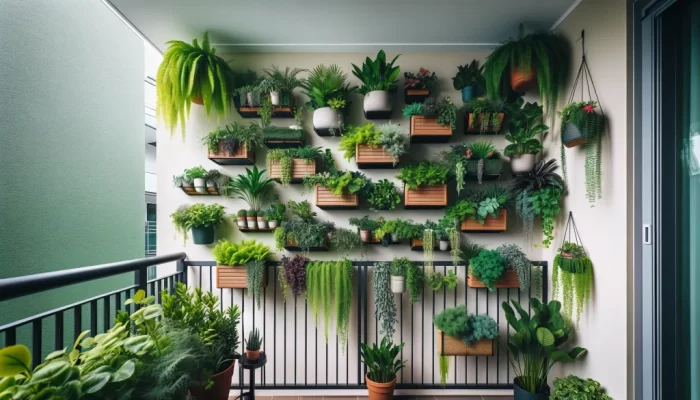Vertical gardening has become an increasingly popular way to grow plants, herbs, and vegetables in small spaces like apartments. By utilizing vertical space on walls, fences, or custom built structures, you can maximize planting area and grow more in less room. Vertical gardens allow urban dwellers and those with limited yard space to tap into gardening and enjoy homegrown produce. In this article we talk about How to Build a Vertical Garden in Your Apartment In 2024.
There are many benefits to vertical gardening. It makes use of unused vertical air space for increased production. Vertical gardens can reduce water usage since the plants aren’t spaced out on the ground. The vertical orientation and air exposure also helps reduce pest and disease pressure. And they provide a great way to add some green into small living spaces.
In this DIY guide, you’ll learn how to create your own vertical garden that can be displayed indoors or outdoors. With simple materials like wood boards, landscape fabric, and hanging hardware, you can build a vertical garden bed that allows you to grow vegetables, herbs, flowers, and more on a wall or railing.
Choosing a Location
When deciding where to install your vertical garden, consider the following:
- Sunlight – Most plants will require at least 6 hours of direct sunlight per day, so choose a sunny wall. South or west-facing walls tend to get good light.
- Accessibility – Make sure the spot you pick allows you to easily access, tend to, and harvest from your vertical garden. Installing it a few feet off the ground will make maintenance easier.
- Structural integrity – Walls, fences, and railings should all be assessed to make sure they can handle the weight of the vertical garden when fully planted and watered.
- Visibility – Pick a spot where you’ll be able to see and enjoy your garden! Near a seating area or kitchen window are great choices.
Materials and Tools Needed
You don’t need fancy supplies or tools to make your own vertical garden. The basic materials include:
- 2-3 wooden boards or square lattice frames for the backing structure (cedar and redwood recommended)
- Landscape fabric to hold soil and line planting pockets
- Staples for securing fabric
- Assorted screws, bolts, hooks, and mounting hardware
- Level
- Drill
- Saw
- Scissors or utility knife
You’ll also need potting soil and whatever plants, seeds, or cuttings you wish to grow. Some great options for vertical gardens include: leafy greens, herbs, strawberries, succulents, and trailing flowers.
Instructions
Follow these simple DIY steps to create your own vertical garden:
- Measure the area where you want to install the vertical garden and cut boards to size. You’ll need one for the bottom, one for the top, and one for every 2-3 feet in between. Pre-drill holes in the boards.
- Screw bottom board directly into wall studs or structural material, using at least 3-4 screws to securely anchor it. Ensure it’s level.
- Attach upper boards using bolts, hooks, or mounting brackets so boards are evenly spaced and secure. The open areas between boards will serve as planting pockets.
- Cut landscape fabric to completely cover the back and sides of the vertical garden, leaving planting pocket areas open. Stretch fabric tight and staple every 2 inches around perimeter to affix to the boards.
- Use scissors to cut slits or X-shaped holes into the fabric where planting pockets are located. These openings will hold your potting soil and plants in place.
- Place a layer of porous landscape fabric against the back of the vertical garden if you’ll be growing vining plants. This protects the wall from moisture and gives vines something to climb.
- Fill planting pockets with potting mix, peat moss, vermiculite, or other soil for vertical gardening. Amend soil as needed for the types of plants you’ll grow.
- Transplant seedlings or plant seeds, cuttings, bulbs or root divisions into pockets as desired. Consider grouping plants that require similar levels of light and water. Install supporting structures for vining plants.
- Hang simple drip irrigation tubing, soaker hoses or hand water to nourish your vertical garden. Set up automatic watering systems if you’ll be away for extended periods.
- Fertilize when installing plants and follow directions for ongoing feeding. Do regular checks and prune back overgrown vegetation as needed over time.
- Step back and enjoy your vertical garden! Change out plants seasonally or fill it with year-round greenery.
Customizing and Caring For Your Garden
The great thing about DIY vertical gardens is you can fully customize them. Try these ideas once your basic structure is built:
- Add decorative elements like mirrors, artwork, shelves or trellises to jazz it up. Integrate fun containers too.
- Use different materials like plastic bottles, mesh pockets, or stacked crates for unique planting beds.
- Expand horizontally across walls with additional boards and fabric or build multi-level tiered designs.
- Grow one type of plant for a unified look or mix flowers, edibles and foliage for variety.
- Use vertical spaces near stairs or on railings and fences for built-in gardens.
Caring for your vertical garden will involve much of the same maintenance as typical container gardening. Water thoroughly when soil dries out and feed plants with a balanced fertilizer. Check for pests and diseases and prune back aggressive growers. With proper care, your vertical garden can flourish for years to come!
The vertical orientation and air circulation makes vertical garden plants less susceptible to diseases and pests than conventional horizontal gardens. However, you still need to regularly observe the garden and apply integrated pest management techniques as needed.
Conclusion
Creating your own vertical garden enables you to grow plants in non-traditional spaces and maximize your planting area. By recycling scrap wood and using affordable materials, you can build a custom vertical garden for your apartment balcony, patio, or indoor space. Vertical gardening opens up new possibilities so you can enjoy growing and eating fresh homegrown produce, even in urban settings or small living quarters.
With this simple DIY vertical garden guide, you now have the key steps and helpful tips to design and install your own planting wall at home using common tools and materials. So grab some boards, fabric, soil and plants and put your vertical gardening skills to work. I sincerely hope you find this “How to Build a Vertical Garden in Your Apartment In 2024” article helpful.

